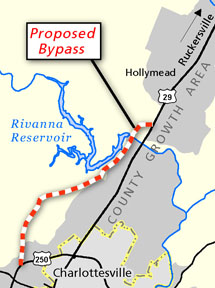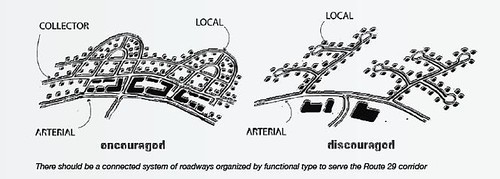If there’s one thing that’s been bypassed in the ongoing push for new roads around DC and Charlottesville, it’s public process.
First, in May, the Commonwealth Transportation Board (CTB) revived plans for a developers’ dream road around DC—the vast Outer Beltway. The unelected CTB brought back the Outer Beltway without consulting local governments, without a recommendation from VDOT, and without any public input.
Over the past decade Loudoun County has rejected proposals for this road three separate times (it’s called the “zombie” beltway because it keeps coming back).

And this spring, Loudoun, Clarke and Fauquier all passed resolutions opposing the route’s designation as a Corridor of Statewide Significance. The CTB declared it one anyway, which means that localities will be forced to incorporate the Outer Beltway into their Comprehensive Plans, whether or not it makes sense. If built, the highway will cost over a billion dollars and encourage sprawling development throughout the northern half of the state.
Then, in June, the Albemarle County Board of Supervisors took a surprise vote near midnight that reversed decades of opposition to the proposed Western Bypass around Charlottesville—a wasteful $250-300 million road that VDOT studies have shown would not fix traffic problems on Rt. 29 North. The Board voted 4-2 to suspend its own rules in order to allow the unannounced vote, and then voted 4-2 in favor of the bypass. In both cases, Supervisors Boyd, Dorrier, Snow and Thomas voted in favor while Supervisors Malleck and Rooker voted against.
For both bypasses, road proponents had to sneak around the public process because the projects are demonstrably bad ideas that have been defeated time and time again.
Albemarle and Richmond make a deal
The proposed Charlottesville bypass is a bad idea because:
- The six mile bypass would simply deposit vehicles back onto a congested section of Rt. 29, at the southern entrance to Forest Lakes, with eleven traffic signals to go in the next twelve miles.
- VDOT studies have shown that the road will not significantly improve traffic on Rt. 29, because only 12% of vehicles on the bypassed stretch of road are through traffic.
- The new road would run near several local schools and the South Fork Rivanna Reservoir, endangering children’s health and polluting the public water supply.
Apparently, the swing vote on the Albemarle Board of Supervisors, Lindsey Dorrier, was won over by a phone call from Virginia Secretary of Transportation, Sean Connaughton, who indicated that if Albemarle approved the bypass, he would try to provide funding both for the bypass and for certain local priorities–a promise that could be hard to keep.
Under pressure from the community, including PEC, for a binding agreement, the Board obtained a letter from Sec. Connaughton clarifying his intentions, although this letter does not amount to a formal commitment. The letter specifies four local transportation projects that Sec. Connaughton promised to “recommend” for funding: Hillsdale Drive, Rt. 29./Rt. 250 ramp and lane improvements, Berkmar Drive Extension and Belmont Bridge. While the CTB has already allocated funding for the bypass and for widening a stretch of Rt. 29, these four projects would have to wait for VDOT’s next six-year plan, which runs from 2012 through 2018.
Access management—better roads, not bigger roads
Sec. Connaughton also stipulated what he described as a “quid pro quo”: transportation funding for Charlottesville and Albemarle will be contingent on the localities implementing better access management along the corridor.
As far as improving access management, PEC is in agreement. PEC is a strong supporter of access management as a cost-effective strategy for improving traffic flow on Rt. 29 and other roads.
Simply put, access management aims to limit the number of driveways, curb cuts and intersections that feed onto a highway or major road. The more points where vehicles are entering or leaving, the more the flow of traffic is disrupted, so travel times slow down and accident rates go up. An article in Bacon’s Rebellion reported that the cluttered Lynchburg Bypass was the site of over five crashes every month, on average, before access management improvements; in the first two months since the improvements were completed this summer, there was not one accident.
According to VDOT: “Studies have demonstrated that a four-lane highway with good access management can carry as much traffic as a six-lane highway with poor access management.”
Combined with other strategies and sensible land-use decisions, better access management can eliminate the need for expensive and damaging new road construction.
What’s not getting built?
Since funding is limited, when some projects win, others lose.
Sec. Connaughton was a force behind not only the Charlottesville bypass but the Outer Beltway, which he said was a priority for Gov. McDonnell. But PEC’s Director of State Policy, Dan Holmes, points out that neither bypass was on the list of over 900 projects to be funded with the $4.1 billion dollars of transportation funding that Gov. McDonnell requested, and got, from the legislature earier this yearl0.
Four billion dollars seems like a lot of money, but when you block out a billion or more for the Outer Beltway and another quarter billion for a short road segment around Charlottesville, it starts running out fast. Already, these expensive bypasses are competing with far more useful transportation investments. In August, when asked to comment on the state’s share of funding for a Metro line extension to Dulles Airport, Sec. Connaughton told the Washington Post, “We don’t have it, and we have no intention of giving it.” Other improvements at stake could include high-speed rail along the I-95 corridor and roadway solutions to east-west traffic in northern Virginia.
While the two bypass roads have been pushed onto transportation plans, both are subject to further review. “Nothing is over until the money is spent,” Mr. Holmes says. “The state still has choices to make, and there are ways we can redirect and make better use of our transportation dollars.” For opportunities to take action, sign up for PEC email alerts.

